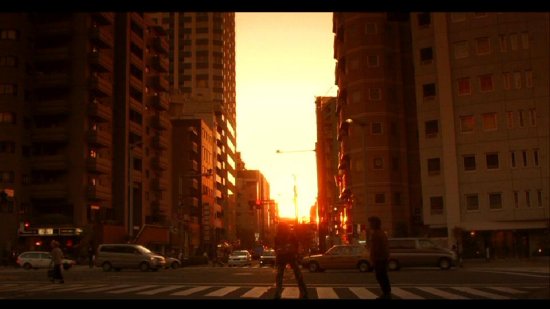Review for Adrift In Tokyo
Introduction
There was a period last summer, following the riots and the torching of the Sony warehouse that held most of Third Window's stock that it seemed that the company was going to give up the ghost. But it turns out that fans of independent Far Eastern cinema are a dedicated bunch, and their determination to keep this essential resource alive made itself felt across the social networks, and indeed across the world. If a DVD label could be classed as a national treasure, Third Window Films would be it. And from the ashes of 2011, they have emerged stronger and more resolute, with a promise of more Eastern delights than ever before for this Olympic year.
To kick off their 2012 campaign, they bring the Satoshi Miki feature, Adrift in Tokyo to the UK. Satoshi Miki has given Third Window Films two of their quirkiest of titles, Turtles Are Surprisingly Fast Swimmers, and Instant Swamp, coincidentally two films which I have a lot of time for. The prospect of yet another Satoshi Miki film filled me with delight, and I was anticipating the check disc with unseemly glee. For those of you who haven't yet had the fortune to appreciate one of these unique works, Third Window Films are also releasing the Satoshi Miki boxset on the same day, collecting Adrift in Tokyo, Turtles Are Surprisingly Fast Swimmers, and Instant Swamp.
Eight years in college with nothing but an 840,000 yen debt to show for it isn't the best of situations to be in for student Fumiya Takemura, especially when you have a debt collector stuffing his sweaty sock down your throat as an object lesson. Given a deadline to come up with the money, Fumiya begins to get desperate, and succumbs to temptation to commit a crime, which is when the debt collector, who has been following him, pounces. Only Ai-ichiro Fukuhara isn't there to increase the pressure, he's there with a proposition that will solve all of Fumiya's problems.
Ai-ichiro has a wad of a million yen, and all that Fumiya has to do to earn it is to accompany Ai-ichiro as they walk through Tokyo. Their destination is a police station in Kasumigaseki where Ai-ichiro wants to give himself up for a certain crime. The catch is that there's no time limit, no set route, and whether it takes 3 days or a month, Fumiya will have to walk with him all the way. There isn't a lot of choice for Fumiya, who thinks he can stomach being with the overbearing older man for as long as it takes, but as they explore the unexpected alleys and unique personalities of Tokyo, both men will find something that neither realises they have been missing.
Picture
Adrift in Tokyo gets a 1.85:1 anamorphic NTSC transfer. We all live in the 21st Century, with flat panel high definition screens, hooked up to progressive equipment, don't we? NTSC and PAL mean so much less now, and I have to say that watching Adrift in Tokyo scaled up to a flat panel display, played back at 24 frames per second is a particular delight. The image is clear and sharp throughout, with strong colours, and rich in detail. Contrast levels are good, and the image brings out the best in the film's cinematography, the various cityscapes and flavours of Tokyo.
Just for the sake of completion, I had a look at the film on an old CRT set, played back at 60 interlaced fields per second at native resolution, and it looked almost as good, with none of the issues such as flicker or judder that can affect NTSC playback on such displays.
Sound
The sole audio option is a DD 2.0 Japanese stereo track, with optional English subtitles. The dialogue is clear throughout, and the film's eclectic soundtrack comes through very effectively. There's a decent bit of separation, and the stereo does a nice job in giving the film room to breathe. Of course a 5.1 audio track would have been preferable, but the audio here is more than acceptable. The subtitles are legible, timed well, and free of error, aside from one subtitle caption a few minutes into the film that hangs on screen until the next line is spoken some seconds later.
Extras
Adrift in Tokyo gets the usual animated menus, and on the disc you'll find 6 trailers for other Third Window Product, a weblink, and the trailer for Adrift in Tokyo.
The most substantial extra however is the 71-minute making of documentary. It's presented as b-roll footage, a behind the scenes look at the shooting of the film, without voice-over guy to put the scenes in context. It's clear to see what is going on though, and the fly on the wall treatment is broken up with brief interviews with the film's supporting cast every few minutes.
Conclusion
This is the best Satoshi Miki film I have seen so far, and given the esteem I hold Turtles and Instant Swamp in, that's saying something. It has the same sense of absurd realism, that slight off-kilter view of things that requires you to tweak your own worldview to better appreciate it, but is all the more fulfilling when you do. Where Adrift in Tokyo excels is that it has a far stronger narrative flow to it, and a dramatic tension infused through it that really makes you empathise with the characters, care about their emotional arcs.
It's a road movie, a languid, idyllic, gentle road movie, conducted at walking pace, but a road movie nonetheless. Two mismatched characters are thrown together, and slowly develop a respect and affection for each other, despite their initial misgivings. Fumiya is the debt ridden student, pressured into accompanying Ai-ichiro on his walk in exchange for cancelling his debt. Fumiya has no family, was abandoned by his parents and raised by a foster family with which he has no emotional connection.
The older Ai-ichiro is the debt-collector who has a change of heart when his own personal circumstances change. He commits a crime which effectively ends his life, and he realises that he has to turn himself in. But he decides to savour his final moments as a free man, to once again indulge in the sort of aimless walks through Tokyo that he used to go on with his wife. Such an experience is best shared, so he makes the offer to Fumiya in order to have someone to accompany him.
Of course the joy of the road movie is in the destination, which I'm not going to spoil at this point. But it's all accomplished with that surreal outlook and skewed perspective that I've come to appreciate from the two other Satoshi Miki films I have seen so far. Every scene is a highlight, every encounter a charming oddity, from Fumiya's only attempt at larceny to service his debt (he steals a bag full of dolls and a broken tengu nose), to the cosplay club, the guitar man and the kung-fu watchmaker. In between, we have asides to the supermarket co-workers of Ai-ichiro's wife, who in between wondering about their colleague's absence, have time to figure out how to smell the tops of their own heads, and get to be extras in a movie. It's delightful absurdity after delightful absurdity.
Adrift in Tokyo is so strong because of its narrative and character arcs though. The journeys that Ai-ichiro and Fumiya go through are very compelling, and ultimately uplifting and moving. What's more is that with Ai-ichiro's crime hanging over him, there's a dramatic tension hanging over the film, a slight sense of impending tragedy and loss, that has you truly feeling for the characters at the conclusion of the film. I wound up wishing that they could have just kept on walking forever. That coupled with the amazing cinematography in the film, the Tokyo cityscapes, the seasonal locations, and the amazing composition of the scenes, all serve to make this film much greater than the sum of its parts.
Adrift in Tokyo is one film that deserves to be in every collection, and of course if you haven't yet had the good fortune of enjoying a Satoshi Miki film, the Satoshi Miki Collection has three gems, including Adrift in Tokyo. There's no better time to get acquainted with his unique style.










































































Your Opinions and Comments
Be the first to post a comment!